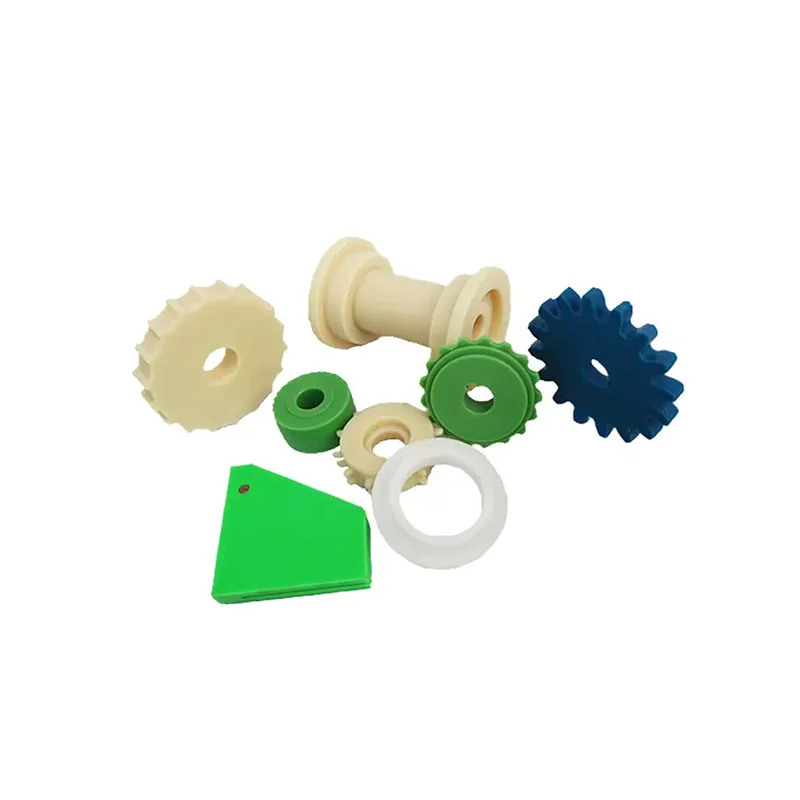- This topic is empty.
-
AuthorPosts
-
2025-05-15 at 6:12 pm #4218
Unlike metal parts, precision plastic parts are favored for their light weight, chemical resistance, dielectric properties, and thermal insulation. In this blog post, as a high quality CNC machining parts manufacturer, Vibo will share the manufacturing process of high precision plastic machining parts for sale.
1. Material Selection and Preprocessing
The journey to manufacturing high-precision plastic components begins with material selection. Unlike metals, plastics are available in a wide array of polymeric formulations, each with unique mechanical, thermal, and chemical characteristics.
1.1 Common Engineering Plastics
* POM (Polyoxymethylene or Delrin): Excellent dimensional stability and low friction.
* PTFE (Polytetrafluoroethylene): Outstanding chemical resistance and low coefficient of friction.
* PEEK (Polyether ether ketone): High temperature resistance and mechanical strength.
* UHMWPE (Ultra-high-molecular-weight polyethylene): Exceptional impact strength and wear resistance.
* Acrylics and Polycarbonates: Used where optical clarity is essential.
1.2 Conditioning and Stress Relieving
Plastic stock often contains internal stresses due to extrusion or casting. These stresses can lead to warping, dimensional inaccuracies, or cracking during machining. Therefore, stress relieving through annealing is a critical preprocessing step. Annealing involves heating the plastic material to a specific temperature below its melting point and then cooling it slowly to release internal stresses without causing deformation.
2. Design and CAD Modeling
High precision demands a meticulous design approach. Engineers must account for plastic' s anisotropic shrinkage, thermal expansion, and potential for deformation.
* Tolerances: Tight tolerances are specified, typically within ±0.001 inches or better, depending on the application.
* Tool Paths: Tool paths must be optimized in CAM (Computer-Aided Manufacturing) software to reduce tool marks, minimize stress on the part, and optimize cycle time.
* Fixturing Considerations: The part geometry must allow for secure fixturing without inducing stress or deformation.

3. Machining Techniques
Plastic machining differs from metalworking in several ways. Plastics are softer, have lower melting points, and are prone to thermal expansion and deformation.
3.1 CNC Milling and Turning
CNC (Computer Numerical Control) milling and turning are the backbone of precision plastic machining.
* Cutting Tools: Sharp, high-helix end mills and carbide or diamond-tipped tools are preferred to minimize heat generation and surface roughness.
* Feed and Speed: Plastics require higher spindle speeds and lower feed rates compared to metals. Typical speeds range from 5,000 to 25,000 RPM depending on the material.
* Coolants: While coolants are generally avoided to prevent chemical contamination, air blasts or vacuum systems are often used to dissipate heat and remove chips.
3.2 Micro-Machining
For extremely small components, micro-machining using ultra-precision CNC machines with micron or sub-micron resolution is employed. Techniques like micro-milling or turning enable the fabrication of intricate features in medical implants or microfluidic devices.
3.3 Laser and Ultrasonic Machining
Some high-performance plastics, especially those used in medical or semiconductor applications, are machined using laser or ultrasonic methods to achieve superior surface finishes and intricate geometries.
4. Tooling and Workholding
Workholding in plastic machining is more delicate than in metalworking due to the potential for deformation under pressure.
* Soft Jaws and Vacuum Fixtures: These methods ensure uniform support and prevent marring or distortion of the plastic component.
* Anti-Static Measures: Some plastics, particularly those used in electronics, are static-sensitive. ESD-safe workholding and grounding are critical.
Tool wear is also a critical concern. Plastics may not abrade tools like metals, but they can cause built-up edges, especially in fibrous or filled materials. Regular tool inspection and replacement schedules are essential to maintain dimensional consistency and surface finish.
5. Thermal Management During Machining
Plastic' s low thermal conductivity and low melting point make thermal management a priority during machining. Excessive heat can lead to:
* Melting and gumming of the plastic around the cutting tool.
* Warping due to uneven thermal expansion.
* Surface degradation including discoloration and poor finish.
To mitigate these issues:
* Sharp tooling minimizes frictional heating.
* Air cooling or chilled air blasts are often used.
* Peck drilling and staged passes help control heat during deep hole drilling or pocketing operations.
6. Post-Machining Processes
Once the machining is complete, several secondary operations may be necessary to achieve final part specifications.
6.1 Deburring and Surface Finishing
Manual or automated deburring is employed to remove sharp edges and burrs. Surface finishing can include:
* Vapor polishing (especially for acrylics) to enhance optical clarity.
* Sanding or buffing for cosmetic finish.
* Ultrasonic cleaning to remove microscopic contaminants, particularly important in cleanroom applications.
6.2 Inspection and Quality Control
Precision plastic parts are often used in safety-critical applications, necessitating rigorous quality control.
* Dimensional Inspection: CMM (Coordinate Measuring Machines), laser scanners, and optical comparators are used to verify tolerances.
* Surface Finish Evaluation: Profilometers assess roughness (Ra values), especially for sealing surfaces or optical components.
* Material Testing: For certain applications, tests for outgassing, biocompatibility, or dielectric strength may be required.
7. Packaging and Handling
Plastics are susceptible to contamination, scratching, and deformation. As such, post-production handling and packaging are designed to preserve the integrity of the components.
* Cleanroom Packaging: For medical or semiconductor parts, packaging in Class 100 or better cleanrooms is standard.
* Static-Safe Bags: Used for electronic components to prevent ESD damage.
* Custom Trays or Foam Inserts: Protect parts from mechanical damage during transport.
Conclusion
The manufacturing process of high precision plastic machining parts is a technically demanding endeavor that integrates advanced material science, CNC machining technology, and meticulous quality assurance. Every stage – from material selection and stress relief to CNC programming and post-processing – requires careful planning and execution. As industries continue to demand lightweight, high-performance, and complex geometries in engineered plastics, manufacturers must evolve their processes to meet increasingly tight tolerances and stringent standards. By investing in state-of-the-art machining equipment, skilled operators, and robust quality systems, manufacturers can deliver the high-precision plastic components that today' s advanced applications demand.
-
AuthorPosts
- You must be logged in to reply to this topic.
